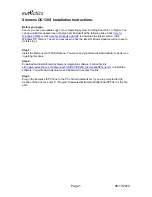
Appendix A
Gabor Expansion and Gabor Transform
©
National Instruments Corporation
A-3
LabVIEW Order Analysis Toolset User Manual
corresponding dual window function from
∆
M
independent linear systems
with the following equation.
(A-4)
where
L
denotes the window length.
denotes a periodic auxiliary
function
1
given by the following equation.
Notice that the solution of Equation A-4 is not unique for over sampling.
A particularly interesting solution for Equation A-4 is the least mean
square error (LMSE). For the LMSE solution, the Euclidean distance
between the dual functions is minimum, as given by the following equation.
where
denotes the matrix form of Equation A-4. When
,
the error is small, and Equation A-2 becomes
(A-5)
Equations A-5 and A-1 form an orthogonal-like Gabor transform pair. In
the case of an orthogonal-like Gabor transform pair, the Gabor coefficients
c
m
,
n
are the projection of the signal on the synthesis window function
h
[
k
].
1
If the window length is equal to the signal length, the periodic auxiliary function
is simply
a
˜
k p
∆
M qN
+
+
[
]γ∗
k p
∆
M
+
[
]
p
0
=
L
∆
M
---------
1
–
∑
δ
q
[ ]
N
-----------
=
0
k
∆
M
<
≤
a
˜
k
[ ]
a
˜
k
[ ]
a
˜
k iL
+
[
]
h k
[ ]
=
0
q
L
N
----
<
≤
a
˜
k i
2
L N
–
(
)
+
[
]
h k
[ ]
0
k L
<
≤
0
L k
2
L N
–
<
≤
=
0
q
2
L
N
------
1
–
<
≤
min
A
γ
u
=
γ
γ
-----
h
–
A
γ
µ
=
γ
h
≈
c
m n
,
s
˜
m
∑
k
[ ]
h k mT
–
[
]
e
j
2
π
nk
–
N
⁄
≈











































